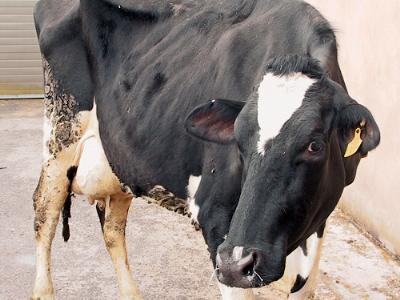Cow Health: Ketosis in the cow

Ketosis is a metabolic disease that occurs when the cow is in severe state of negative energy balance.
In this state, the cow mobilises large quantities of body fat but cannot convert this to energy through the usual pathways. Instead, ketone bodies are produced which in small amounts can be used by the cow for energy.
However, when ketone production is high, the cow cannot use all the ketone bodies for energy and ketone levels increase in the blood. When this occurs the cow may suffer from ketosis.
Types of Ketosis
Type 1 ketosis is a result of a sudden drop in energy intake. This can be due to underfeeding or adverse weather events (e.g. snow storms) that prevent the cows from eating sufficient amounts of dry matter.
Type 2 ketosis generally occurs post-calving, when the cow is mobilising excess body fat to meet the demands of milk production. Cows that are too fat at calving (BCS > 5) or cows that have been overfed pre-calving are particularly at risk.
Silage ketosis is due to cows ingesting poor quality silage. The silage undergoes a secondary fermentation and when ingested will increase the risk of ketosis.
Symptoms
Ketosis can be displayed in two ways:
Wasting form
- Lethargy (head down, lack of energy)
- Decreased dry matter intake
- Decreased milk production
- Often a sweet smell on the breath (acetone)
Nervous form
- Excitable, uncoordinated and can become aggressive
- Strange behaviour such as eating soil, licking fence posts and gates, walking in circles, or standing with heads raised up and pushed into a corner etc.
If a cow shows signs of ketosis seek advice from your veterinarian
Prevention
It is important to prevent ketosis from occurring, rather than treating cases as they appear.
Prevention depends on adequate feeding and management of body condition score (BCS).
- Ensure cows calve at recommended BCS targets – 5.0 for mixed aged cows, 5.5 for heifers and second calvers
- If at target BCS, feed springers 80 – 90 percent of energy requirements during the last one to two weeks pre-calving
- Good feed management in early lactation - target post-grazing residuals of 1500-1600 kg DM/ha and take into account adverse weather conditions
- Avoid feed restrictions if possible (i.e. use supplementary feeds); if restrictions are unavoidable, introduce the feed shortage gradually or milk cows once-a-day
- Ensuring silage is of high quality, and stored correctly
Treatment
Treatments that have been used in severely affected cows include intravenous metabolic solutions (e.g. 4-in-1; Ca, Mg, P, glucose), intravenous dextrose and multivitamin injections.
Treatment should follow veterinary advice.
What you can do
If the affected animal is still able to stand
- Increase energy content of the diet
If the animal is not able to stand
- Provide it with shelter, soft bedding and continued nursing, including regular rolling from side to side to avoid sores
- Provide water and high-quality supplements, supported by oral administration (twice daily) of glucose precursors such as propylene glycol
- Use hip-lifters or similar lifting devices to assist the affected cow to her feet for some time. Hip clamps can only be used to help a cow stand, but not to keep her standing. A sling may be used for up to one hour only if the cow cannot support her own weight.
Related Information
Ketosis information sheet (Feedright)
DairyNZ Technical Series June 2012 - Avoiding metabolic diseases, pages 13-18.
Related news
 Cow Health: Diarrhoea in Calves (Scours)
Cow Health: Diarrhoea in Calves (Scours) Calf scours is a broad, descriptive term referring to diarrhoea in calves. Calf scours is not a specific disease but the clinical sign of a disease complex with
 Cow Health: Copper deficiency
Cow Health: Copper deficiency Copper (Cu) deficiency in cattle is a common and complex problem. Dairy cows are most likely to be deficient in winter/early spring, coinciding with higher
 Cow Health: Sodium deficiency
Cow Health: Sodium deficiency Sodium is an essential element for animals. Dairy cows routinely expel Na from the body in urine, faeces, saliva and milk which has to be replaced.